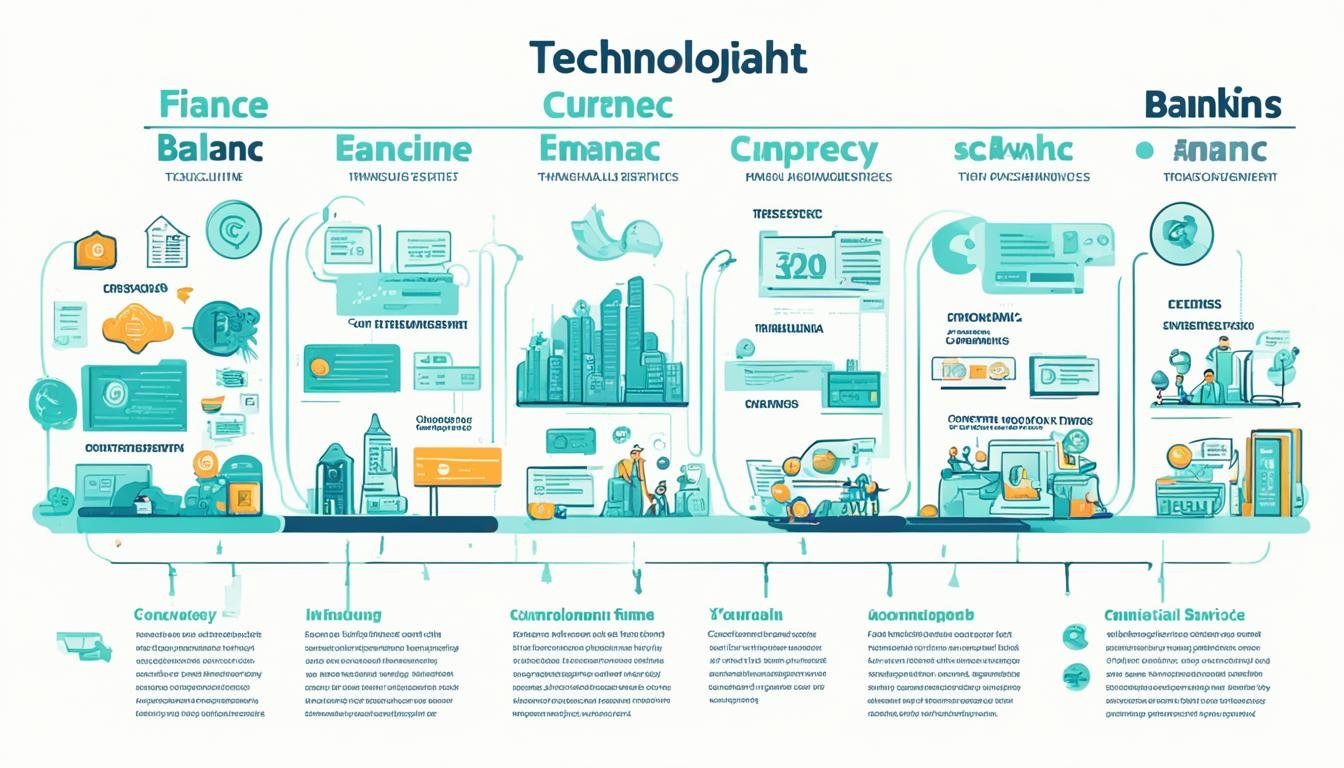The Evolution of FinTech: A Historical Perspective
Did you know that the global FinTech industry is projected to reach a value of $460 billion by 2025? This staggering statistic reveals the immense growth and impact of financial technology on our modern society. But how did we get here? Let’s take a journey through the history of FinTech, exploring its evolution, key milestones, and the forces that have shaped this dynamic industry.
Key Takeaways:
- FinTech is a rapidly growing industry set to reach a value of $460 billion by 2025.
- The history of FinTech encompasses key milestones and innovations that have revolutionized the financial industry.
- Technological advancements, regulatory changes, and consumer demands have shaped the evolution of FinTech.
- The future of FinTech will continue to focus on areas like artificial intelligence, financial inclusion, and cybersecurity.
- Understanding the historical perspective of FinTech provides insights into its transformative power and potential future developments.
The Birth of FinTech
The fintech industry has a rich history that dates back to the 1950s, with the birth of electronic data processing within traditional financial institutions. This era marked the beginning of significant innovations that would shape the foundation of fintech as we know it today.
One of the early game-changers was the introduction of credit cards, revolutionizing the way people made payments and eliminating the need for cash transactions. Credit cards provided consumers with a convenient and efficient way to access credit and make purchases, propelling the growth of the financial industry.
Another pivotal innovation was the development of Automated Teller Machines (ATMs), also known as cash machines. ATMs revolutionized banking by providing individuals with 24/7 access to their funds. No longer confined to banking hours, people could withdraw cash, check their account balances, and even make deposits at any time of the day or night.
Furthermore, electronic data processing played a crucial role in automating financial processes such as transaction processing and record-keeping. This technological advancement enabled financial institutions to handle large volumes of data more efficiently and accurately, streamlining operations and enhancing the customer experience.
These early innovations laid the groundwork for the fintech industry, introducing concepts such as consumer credit, cash access outside of regular banking hours, and the digitization of financial transactions. They set the stage for the exponential growth and transformative impact that fintech continues to have on the financial landscape.
Innovations like credit cards and ATMs played a significant role in shaping the foundation of fintech, streamlining payment processes and introducing new concepts like consumer credit and cash access outside of regular banking hours.
As we delve deeper into the history of fintech, it becomes evident that these early innovations were the stepping stones for the technological advancements and disruptive innovations that followed. The birth of fintech marked the beginning of a revolution that continues to reshape the financial industry to this day.
The Digital Revolution
The rise of the internet and personal computing in the 1990s marked a significant development in the world of financial technology. This era, often referred to as the digital revolution, brought about a fundamental change in the way people manage their finances and conduct financial transactions.
One of the key innovations that emerged during this time was online banking. With the advent of the internet, individuals could now access their bank accounts and perform various financial transactions from the comfort of their homes or offices. This convenience and accessibility revolutionized the banking industry, making it easier than ever before for people to manage their money.
Online brokerage services also gained prominence during the digital revolution. Investors could now trade stocks, bonds, and other financial instruments online, eliminating the need for traditional brick-and-mortar brokerage firms. This democratization of investing opened up new opportunities for individuals to participate in the stock market and take control of their investment portfolios.
The digitization of financial transactions played a crucial role in shaping not only banking and investing but also the broader landscape of e-commerce. As more people gained access to the internet and engaged in online activities, the need for secure and convenient payment methods became paramount. Fintech companies, like PayPal, emerged to address this need and revolutionize online payments. These innovative solutions not only facilitated seamless transactions but also contributed to the growth and development of online marketplaces.
The digital revolution of the 1990s laid the foundation for the fintech industry we see today. By harnessing the power of the internet and personal computing, individuals were empowered to take control of their financial lives and conduct transactions with ease and efficiency.
The Fintech Startup Boom
In the early 2000s, the fintech industry experienced a significant boom with the emergence of innovative startups that disrupted various aspects of the financial industry. These fintech startups brought a wave of innovation, challenging traditional institutions and opening the door to alternative, customer-centric solutions.
One notable fintech startup that emerged during this time was Square, founded in 2009. Square revolutionized small businesses by providing innovative solutions that allowed them to accept card payments using smartphones or tablets. This alternative payment method enabled small businesses to enhance their customer experience and streamline their transactions.
“Fintech startups like Square have played a key role in disrupting the traditional payment landscape, empowering small businesses with affordable and accessible card payment solutions.”
The financial crisis of 2008 further fueled the growth of fintech startups. The crisis exposed weaknesses in traditional financial institutions and highlighted the need for alternative solutions that prioritize the needs of customers. Fintech startups seized this opportunity to provide innovative lending, payments, wealth management, and insurance solutions that catered to the changing demands of consumers.
As a result of the fintech startup boom, the financial industry experienced a significant shift, with traditional institutions facing increased competition and pressure to adapt to the changing landscape.
Alternative Solutions for the Modern Financial Landscape
The rise of fintech startups introduced alternative solutions to traditional financial services, disrupting the industry and offering new possibilities for consumers and businesses alike. Some of the key areas where fintech startups have made a significant impact include:
- Lending: Fintech lending platforms have democratized access to capital, providing alternative lending options for individuals and small businesses.
- Payments: Fintech startups have transformed the payment landscape by offering convenient and secure alternatives to traditional payment methods.
- Wealth Management: Fintech platforms have revolutionized wealth management by providing affordable and accessible investment solutions, enabling individuals to take control of their financial future.
- Insurance: Insurtech startups have harnessed technology to streamline insurance processes, making insurance more transparent and personalized for consumers.
The fintech startup boom has brought about a wave of disruption, challenging the status quo and driving the industry towards more innovative and customer-centric solutions.
Mobile Banking and Payments
The proliferation of smartphones in the 2010s has ushered in a new era of fintech, revolutionizing the way we manage our finances. With mobile banking apps and digital wallets becoming increasingly popular, consumers now have convenient and secure ways to access their accounts and make payments on the go.
Mobile banking apps provide a range of financial services at our fingertips, allowing us to check account balances, transfer funds, pay bills, and even apply for loans, all from the convenience of our smartphones. Gone are the days of visiting a bank branch or waiting in long queues. With a few taps on our mobile screens, we can complete transactions within seconds and keep track of our financial activities in real-time.
Digital wallets have also gained widespread adoption. These virtual wallets enable users to store and manage their payment information securely. By linking their bank accounts or credit cards to digital wallets, consumers can make seamless and secure payments through their smartphones or other mobile devices. With support from various payment platforms and merchants, digital wallets have become widely accepted, making cashless transactions the norm.
The rise of mobile payments has not only transformed the way we transact but has also opened up new opportunities for peer-to-peer lending platforms. These platforms connect borrowers directly with investors, providing a decentralized alternative to traditional banks. Through mobile apps, individuals can easily access loans, and investors can diversify their portfolios by funding loans directly.
Blockchain and Cryptocurrency
One of the most significant disruptions in fintech came with the emergence of blockchain technology and cryptocurrencies. Bitcoin, introduced in 2009, marked the beginning of the cryptocurrency revolution. Blockchain technology offered a decentralized and immutable ledger for various financial applications beyond cryptocurrencies. The rise of Initial Coin Offerings (ICOs) in 2017 further showcased the innovative potential of blockchain, although it also raised regulatory concerns.
The decentralized nature of blockchain technology has the potential to revolutionize various sectors, including finance. By removing the need for intermediaries, blockchain enables decentralized finance, also known as DeFi. This means individuals can participate in financial activities such as lending, borrowing, and investing without relying on traditional banks or centralized financial institutions.
The Benefits of Blockchain Technology
Blockchain technology provides several key advantages:
- Transparency: The decentralized and transparent nature of blockchain allows for real-time visibility into transactions, enhancing trust and reducing fraud.
- Security: The use of cryptographic algorithms ensures that transactions recorded on the blockchain are secure and tamper-proof.
- Efficiency: Blockchain enables faster and more efficient settlement of transactions, eliminating the need for intermediaries and reducing costs.
- Accessibility: Blockchain technology enables financial inclusion by providing access to financial services for the unbanked and underbanked populations.
Blockchain technology has applications beyond cryptocurrencies. Smart contracts, for example, are self-executing contracts with the terms of the agreement recorded on the blockchain. These contracts automatically execute when predefined conditions are met, eliminating the need for intermediaries and reducing costs.
Blockchain technology has the potential to disrupt not only the financial industry but also various sectors such as supply chain management, healthcare, and voting systems.
The Rise of Cryptocurrencies
Bitcoin, the first cryptocurrency, gained popularity due to its decentralized and digital nature. Cryptocurrencies operate on blockchain technology, allowing for secure and transparent transactions. While Bitcoin is the most well-known cryptocurrency, there are now thousands of cryptocurrencies in existence, each with its own unique features and use cases.
Cryptocurrencies offer benefits such as:
- Decentralization: Cryptocurrencies are not controlled by any central authority, making them resistant to censorship and government interference.
- Fast Transactions: Cryptocurrency transactions can be completed quickly, regardless of geographical boundaries, making them ideal for cross-border payments.
- Lower Transaction Fees: Cryptocurrency transactions often have lower fees compared to traditional financial systems, especially for international transfers.
- Investment Opportunities: Cryptocurrencies provide individuals with investment opportunities, as their value can fluctuate and potentially generate substantial returns.
While cryptocurrencies offer exciting opportunities, they also come with risks. The price volatility of cryptocurrencies can lead to substantial gains or losses, making them a high-risk investment. Regulatory concerns, including anti-money laundering (AML) and know your customer (KYC) requirements, are also important considerations in the cryptocurrency space.
| Cryptocurrency | Market Cap (as of April 2021) | Key Features |
|---|---|---|
| Bitcoin (BTC) | $1.2 trillion | First cryptocurrency, widely accepted as a digital store of value. |
| Ethereum (ETH) | $250 billion | Platform for building decentralized applications (dApps) and executing smart contracts. |
| Ripple (XRP) | $50 billion | Designed for fast, low-cost international money transfers. |
| Litecoin (LTC) | $20 billion | Similar to Bitcoin, but with faster block generation times and a different hashing algorithm. |
| Cardano (ADA) | $35 billion | Poised to provide a platform for the development of decentralized applications and smart contracts. |
Regulatory Challenges and Collaboration
As the fintech industry continued to grow rapidly, regulators worldwide faced the intricate challenge of striking the right balance between fostering innovation and protecting consumers. To navigate this complex landscape, regulatory frameworks evolved to address critical issues like data privacy, cybersecurity, and financial stability.
Regulatory frameworks were designed to establish clear guidelines and standards that fintech companies must adhere to, ensuring the security and privacy of customer data. These frameworks aimed to mitigate the risks associated with fintech services by imposing strict data protection measures, including encryption protocols, access controls, and robust cybersecurity frameworks.
The rise of fintech also brought about new challenges related to financial stability. Regulators realized the need to monitor and regulate fintech activities to prevent potential disruptions to the financial system. They implemented measures to promote responsible lending practices, monitor investment platforms, and oversee the functioning of peer-to-peer lending and crowdfunding platforms.
Furthermore, traditional financial institutions recognized the potential of fintech innovation and actively sought collaborations with fintech companies. They saw partnerships and acquisitions as a means to leverage fintech expertise and technology to enhance their own service offerings. By collaborating with fintech startups, traditional financial institutions aimed to stay competitive and deliver innovative solutions to their customers while leveraging their existing customer base and regulatory knowledge.
“Collaboration between fintech startups and traditional financial institutions has been instrumental in driving innovation within the industry. Traditional institutions have been able to tap into the agility and technological advancements offered by fintech startups, while startups benefit from the established customer base and domain expertise of traditional institutions.”
To illustrate the collaborative efforts between fintech startups and traditional financial institutions, the following table highlights some notable partnerships and acquisitions:
| Fintech Startup | Traditional Financial Institution | Type of Collaboration |
|---|---|---|
| Stripe | JPMorgan Chase | Partnership to enable seamless payment processing |
| Wealthfront | MSCI Inc. | Acquisition to enhance wealth management capabilities |
| Lemonade | AXA | Partnership to offer innovative insurance solutions |
This collaboration between fintech startups and traditional financial institutions has not only driven innovation within the financial industry but also fostered a supportive environment for future advancements. By working together, these entities have been able to pool their resources, knowledge, and expertise to create customer-centric solutions that combine the agility of fintech startups with the stability and trust associated with traditional financial institutions.
Key Takeaways:
- Regulators face the challenge of balancing innovation and consumer protection in the rapidly growing fintech industry.
- Regulatory frameworks have evolved to address data privacy, cybersecurity, and financial stability concerns.
- Collaboration between fintech startups and traditional financial institutions has resulted in partnerships and acquisitions that drive innovation within the industry.
The Future of Fintech
As the fintech industry continues to evolve, the future holds exciting advancements in various technologies that are set to reshape the financial landscape. Key areas of focus include artificial intelligence (AI), machine learning, big data analytics, decentralized finance (DeFi), financial inclusion, regulatory developments, and cybersecurity threats.
Advancements in AI, machine learning, and big data analytics will drive transformative innovations within the fintech industry. These technologies offer immense potential in areas such as fraud detection, credit scoring, risk assessment, and personalized financial advice. By leveraging AI algorithms and utilizing vast amounts of data, fintech companies can provide more accurate insights and tailored solutions to individual customers.
Decentralized finance is another key area that holds promise for the future of fintech. Through blockchain technology, decentralized financial systems are emerging, offering increased transparency, security, and efficiency. This opens up new possibilities for peer-to-peer lending, decentralized exchanges, and smart contracts, disrupting traditional intermediaries and enabling direct interactions between individuals.
Financial inclusion remains a crucial objective for the fintech industry. Advancements in digital payment systems, mobile banking, and alternative lending platforms have already made significant strides in bringing financial services to underserved populations. The future will see further innovations that lower barriers to entry, making financial services accessible to individuals and small businesses worldwide.
In the face of rapid innovation, regulatory developments play a critical role in ensuring consumer protection and maintaining stability in the financial system. Governments and regulatory bodies are working to develop frameworks that foster innovation while addressing concerns related to data privacy, consumer rights, and systemic risks. Striking the right balance is crucial to facilitate fintech growth while safeguarding the interests of all stakeholders.
However, as fintech continues to advance, it also faces cybersecurity threats that need to be addressed. The interconnected nature of digital financial systems makes them vulnerable to hacking, data breaches, and other malicious activities. Maintaining strong cybersecurity infrastructure and implementing robust measures to protect sensitive data are of utmost importance for fintech companies and their customers.
| Technology | Impact on Fintech |
|---|---|
| Artificial Intelligence | Enables personalized financial advice and fraud detection |
| Machine Learning | Improves credit scoring and risk assessment |
| Big Data Analytics | Provides insights for better decision-making and customer service |
| Decentralized Finance | Disrupts traditional intermediaries and enables peer-to-peer transactions |
| Financial Inclusion | Expands access to financial services for underserved populations |
| Regulatory Developments | Safeguards consumer protection and stability in the financial system |
| Cybersecurity Threats | Presents challenges in protecting sensitive financial data |
In conclusion, the future of fintech holds tremendous potential for advancements in artificial intelligence, machine learning, big data analytics, decentralized finance, financial inclusion, regulatory developments, and cybersecurity. These innovations will shape the way individuals and businesses access and manage financial services. It is crucial for the industry to adapt to these changes, while simultaneously addressing challenges to ensure a secure and inclusive financial ecosystem.
The FinTech Ecosystem Today
The current FinTech ecosystem is a dynamic and continuously evolving landscape that offers a wide range of innovative solutions to meet the evolving needs of individuals and businesses alike. This rapidly growing industry is driven by various cutting-edge technologies and services, including robo-advisors, algorithmic trading, crowdfunding platforms, and InsurTech.
Robo-advisors have revolutionized the investment landscape by providing automated and algorithm-based portfolio management services. These platforms use artificial intelligence and machine learning algorithms to analyze market trends and investor preferences, offering personalized investment strategies and recommendations.
Algorithmic trading has transformed the way financial markets operate. By utilizing complex mathematical models and big data analytics, algorithmic trading algorithms can execute high-speed trades and make split-second decisions based on pre-determined criteria, enhancing trading efficiency and liquidity.
Crowdfunding platforms have democratized fundraising by connecting entrepreneurs and individuals looking to invest in innovative projects or support charitable causes. These platforms leverage technology to facilitate peer-to-peer transactions and enable individuals to contribute to various initiatives, from startups to social initiatives.
InsurTech has disrupted the traditional insurance industry, leveraging technology and data analytics to provide tailored insurance solutions and streamline the claims process. Artificial intelligence and big data analytics enable insurers to assess risk, customize coverage, and enhance operational efficiency.
The integration of emerging technologies such as artificial intelligence, machine learning, and big data analytics is driving further advancements in the FinTech ecosystem. These technologies enable the development of innovative financial products and services, personalized customer experiences, and predictive insights.
The image above illustrates the concept of big data analytics, which plays a crucial role in the FinTech industry. By analyzing vast amounts of data, FinTech companies can gain valuable insights into customer behavior, market trends, and risk management, enabling them to make data-driven decisions and optimize their offerings.
Conclusion
The historical perspective of FinTech showcases the remarkable transformation brought about by innovation in the financial industry. Starting from its inception to its current state, FinTech has revolutionized the way we conduct transactions, invest our money, and manage our finances. It has disrupted traditional practices, opening up new possibilities for individuals and businesses alike.
Looking ahead, the evolution of FinTech will continue to be driven by ongoing innovation and adaptation. The industry will prioritize increasing financial inclusion, ensuring that a wider range of individuals and businesses have access to financial services. Additionally, the focus will be on addressing crucial regulatory challenges and cybersecurity threats, safeguarding the interests of consumers and protecting financial systems.
Advancements in technologies such as artificial intelligence, machine learning, and big data analytics will play a pivotal role in shaping the future of FinTech. These innovations will enhance fraud detection capabilities, provide personalized financial advice, and improve overall customer experience. As a result, the industry will become increasingly efficient, tailored, and responsive to the evolving needs of its users.
Ultimately, the transformative power of FinTech will continue to reshape the financial landscape, making it more accessible, inclusive, and secure. By leveraging the ongoing advancements in technology and prioritizing the needs of consumers, FinTech will shape the future of finance, enabling individuals and businesses to thrive in an increasingly digital and interconnected world.
FAQ
What is the historical perspective of FinTech?
The historical perspective of FinTech traces its roots back to the 1950s with the emergence of electronic data processing within traditional financial institutions. Innovations like credit cards and ATMs played a significant role in shaping the foundation of FinTech.
What were some early innovations in FinTech?
Early innovations in FinTech included the introduction of credit cards and Automated Teller Machines (ATMs). These innovations streamlined payment processes and introduced concepts like consumer credit and cash access outside of regular banking hours.
How did the rise of the internet and personal computing impact FinTech?
The rise of the internet and personal computing in the 1990s led to the birth of FinTech as we know it today. Online banking and brokerage services emerged, allowing individuals to manage their finances electronically. This digitization of financial transactions paved the way for e-commerce and online payment solutions like PayPal.
How did the financial crisis of 2008 impact the FinTech industry?
The financial crisis of 2008 exposed weaknesses in traditional financial institutions and opened the door for alternative, customer-centric solutions. It provided an opportunity for FinTech startups to disrupt the industry and offer innovative solutions that addressed the shortcomings of traditional banking.
How did the proliferation of smartphones impact FinTech?
The proliferation of smartphones in the 2010s brought about a new era of FinTech. Mobile banking apps and digital wallets became ubiquitous, allowing consumers to manage their finances and make payments on the go. Peer-to-peer lending platforms also gained traction, providing an alternative to traditional banks for borrowers and investors.
How did blockchain and cryptocurrencies impact FinTech?
The emergence of blockchain technology and cryptocurrencies introduced a decentralized and immutable ledger for financial applications. Bitcoin, introduced in 2009, marked the beginning of the cryptocurrency revolution. Blockchain technology has since showcased its potential beyond cryptocurrencies, but also raised regulatory concerns.
How did regulations impact the FinTech industry?
As FinTech continued to grow, regulators worldwide faced the challenge of balancing innovation and consumer protection. Regulatory frameworks evolved to address issues such as data privacy, cybersecurity, and financial stability. FinTech companies also started collaborating with traditional financial institutions, driving innovation within the banking sector.
What is the future of FinTech?
The future of FinTech will see advancements in technologies like artificial intelligence, machine learning, and big data analytics. These technologies will drive innovations in areas such as fraud detection, credit scoring, and personalized financial advice. The industry will also focus on financial inclusion, providing previously unavailable financial services to more individuals and businesses.
What is the current state of the FinTech ecosystem?
The current FinTech ecosystem is diverse and continually evolving. It encompasses innovations such as robo-advisors, algorithmic trading, crowdfunding platforms, and InsurTech. Emerging technologies like artificial intelligence, machine learning, and big data analytics are driving further advancements in personalized financial services and predictive insights.








